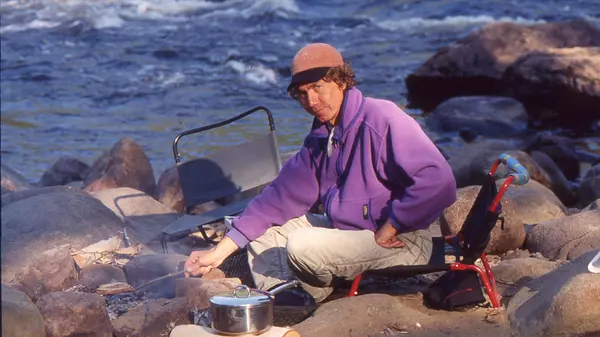In the Côte-Nord region of Quebec lies the Minganie - a culinary paradise that boasts of delicious and unique food offerings. Fresh seafood is a specialty and there is something for every taste in Minganie. Chef Clément Boivin, our ambassador, has created various gourmet dishes during his stay there. He also shares his beautiful culinary discoveries, which will make food lovers salivate and add Minganie to their next vacation destination.
It's May 2023, and spring has arrived with a bang this year. The dry weather has resulted in an early forest fire season. I am planning to visit the outfitter in Minganie, which is 1200 kilometers away from Montreal. Every year, I explore and meet new producers, artisans, and fishermen to offer menus that are authentic to the regions I visit.
Improvisation and Forest Fires
My partner Julien and I embarked on a journey towards the North Shore in a packed car. Unfortunately, the bridge connecting Minganie to the rest of the world was closed for urgent renovations. However, we learned that some people were assisting certain citizens to make the crossing by zodiac. Additionally, forest fires were rampant in Franquelin, causing Route 138 to close to all traffic, and the city of Sept-Îles had just evacuated 5000 of its residents. Our adventure began in a somewhat eerie atmosphere, with a hint of a doomsday feel. To let some time pass, we had to make a detour to Saguenay, and we were warmly welcomed at the Chlorophylle store. Conscious of our challenges and mission, we left with waterproof, sturdy, and breathable clothing to keep us dry in what promised to be a more complicated adventure than we had anticipated.
Finally, after a few hours, we arrived in Longue-Pointe-de-Mingan. We had to cross the former abandoned military airport to reach the dirt roads that run alongside the blueberry fields, eventually leading us to the camp, our final destination. Once we arrived, we unloaded, set up, and started cooking.

Halibut and Scallop Shells
Our next destination is Havre Saint-Pierre, where we plan to visit a fish market that also serves as a seafood factory. However, it's essential to note that the region has many fish and seafood processing factories, and you must arrive at the right time. Most of these factories do not have a counter for individual sales, as their products are mainly sold and exported abroad. Luckily, we were able to get some local halibut during our first visit. A few days later, we received a call informing us that scallops in shells had arrived. It was interesting to see the surprise on people's faces when we insisted on getting them raw and uncleaned. The scallop gonad, with its bright orange color, is delicious when cooked. Furthermore, the shell is fascinating for presentations, and I've always dreamt of creating utensils with it. To be continued.

John, the oyster farmer, and his project of local oysters
By chance, I meet John, an oyster farmer on Anticosti Island, during one of my first encounters in Minganie. He is the former mayor of Port-Menier and he confides in me his retirement project that has been occupying him for the past 5 years. He has conducted several rigorous tests and will soon be commercializing farmed oysters for the very first time.
His plan is to produce these oysters for the people of his community and for people who visit the big island. He may also aim to offer his precious shells to fish markets on the North Shore, for those who may be interested. He tells me that they will probably be ready by June 20, which is halfway through my visit in Minganie. I am surprised by the incredible timing!
It is important to know that oysters are symbolic of the land to me. They grow by filtering seawater for nourishment, in this case, on a remote island in the world, at least in my eyes. I fall in love with his product, which is the first promise of a long culinary adventure that will last 45 days, from the first morning coffee to the last dessert in the evening.

The striped bass and its delicious flesh
Every day, we go through meals, morning, noon and night. We face challenges, surprises, and of course, the unpredictable propane refrigerator. Sometimes it causes problems, but it's all part of the adventure. Unfortunately, we've been told that fishing hasn't been great this year. Jocelyn, also known as Tintin, the outfitter's handyman who knows the secrets of the Saint John River, complains that there's too much water too early. This means the salmon may have already gone up to the river jump 60 miles away. Nevertheless, we're still committed to making our guests' stay unforgettable and providing them with delicious food.
Luckily, the striped bass, a fish that's increasingly found at the mouth of the Saint John River and the Gulf, has become the star of our cuisine. This fish is vigorous, abundant, fatty, and truly delicious, but unfortunately, it's not very popular among the locals. It has a reputation for eating salmon fry and smolts, but it's a lifesaver for us. Salmon is king here, and our local friends even give us their catch if our fishing isn't going well. Thanks to the striped bass, we now have a newfound respect for this underrated fish.
Fishing for sea urchins
There are organized cruises to the Mingan Islands, particularly to the bare island where sedimentary rock monoliths mix with moors. It is a vast area without trees, and a miniature forest of lichens and native plants populates most of the island's center. The waves, pebbles, and rocks make for a magnificent view. Harold, the boat captain who takes us to the island, teaches us how to fish for sea urchins with a mop in shallow water at the edge of the dock. We let the guests leave on one side, while Julien, Esteban, one of our collaborators in the Free Cuisine project, and I walk to the other to organize a picnic on the rocks. These rocks will serve as dishes or furniture facing the sea. Our menu will consist of sea urchins, periwinkles, and the Anticosti oysters that arrived a few days ago.

An incredible opportunity: tasting rock shrimp
During my journey, I experienced some magical moments of surprise. On my way back from a cruise to the islands, I met a colleague of Harold, the sailor, who introduced me to a fisherman in Longue-Pointe de Mingan. Most of the commercial fishing boats in the area have been purchased by the Innu community. I had an incredible encounter at the Mingan dock after a successful mackerel fishing trip. It was then that I finally met the fisherman. He was fishing for sea cucumbers, and in his dredge, he often found "scampi." Due to his Innu origin, he had the right to keep whatever he wanted for personal consumption. I did some research and discovered the St. Lawrence rock shrimp, which is slightly larger than the northern shrimp and when eaten raw, it is very sweet. I learned that there have been past considerations to sell this species locally, and I hope that this initiative can be revived.
In conclusion
The variety and abundance of seafood in Minganie have allowed me to discover a rich range of culinary delights. From the halibut found in Havre Saint-Pierre, to the fresh scallops, John's farmed oysters, and the delicious striped bass - I have also learned how to fish for sea urchins and had the opportunity to taste the northern shrimp, thanks to the Ilnu fisherman Harold. Each time, I was impressed by the authentic and local flavors that made my gastronomic experience even more special. I consider it a privilege to showcase the unique and delicious products of our region through my project, Cuisine libre, and to awaken people's senses to the wonders of local cuisine.
Blog
See allSign up to get 10% off your first order.
A confirmation email containing your promotional code will be sent to you. If you cannot find it in your inbox, please check your spam folder.
By subscribing, you accept that we will send you emails concerning promotions, events, products and other exclusive advantages that are only available to our subscribers.






